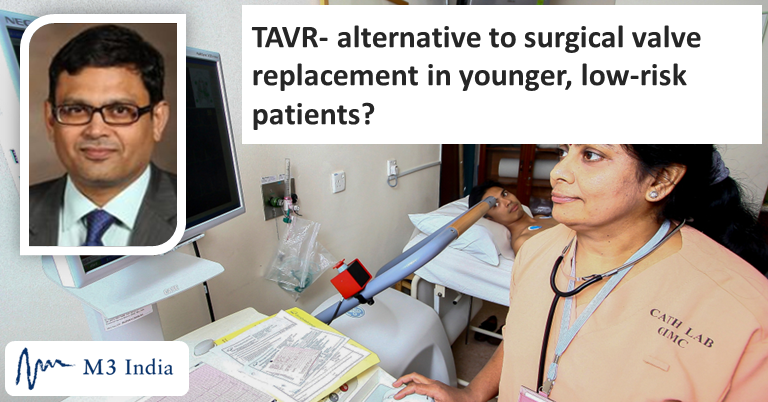'Can TAVR become an alternative to surgical valve replacement in younger, low-risk patients?'- Dr. Sundeep Mishra opines
M3 India Newsdesk Jun 24, 2019
Prof. Dr. Mishra mentions that, though classically, surgical aortic valve replacement (SAVR) is the gold-standard in younger patients, with TAVR restricted to only older patients due to long term stability of surgical valves, careful selection of patients and valve type may all lead to a dramatic reduction in already low complications so much so that TAVI/TAVR may become an alternate in low-risk and younger patients.

The goal of modern medicine is to fight death and decrease disease and disability. To achieve this goal, the whole field evolves in a way that therapy becomes more and more efficacious (prolongs life) as well as is safer and less disabling. Thus, there is an ongoing quest to make therapy less invasive and more convenient, of course without losing any of its efficacy. In pursuit of this comes a constant shift towards a simpler form of treatment, from surgical to interventional to intravenous, or even oral. It is in this context that it is not surprising that we have seen more number of patients being treated with percutaneous coronary interventions (PCI) than coronary artery bypass grafting (CABG) and still more patients being treated with medical therapy like statins or anti-anginals than PCI.
Logically, one would expect that less invasive therapy would first be applied in less sicker patients before being applied to really sick ones. However, one of the principal precepts of medicine is “Primum non nocere” which is a Latin phrase that means “first, do no harm.” This fundamental principle of medicine reminds the healthcare provider that they must consider the possible harm that any intervention might do even before considering the possible benefit.
Its real world application in medical practice that translates into any newer intervention/therapy being used first in only “no-option patients.” Only when benefit is well established in these patients, way beyond possible harms can the new therapy be applied in less sicker sub-sets. Percutaneous valve therapy is no exception.
Trans-cutaneous valve implantation (TAVI) has witnessed rapid evolution in terms of technical design, efficacy, and safety outcomes. Initially applied to inoperable or high-risk surgical patients (Society of Thoracic Surgeons score >10%, surgeon assessed risk of mortality >15%), there is now some evidence to suggest that patient selection for trans-cutaneous valve implantation/replacement (TAVI/TAVR) is now shifting toward lower surgical risk patients.
With the evolution of technology, newer generation devices have a lower strut thickness, better frame geometry, and lower profile. Further, they may provide a better supra-, infra-, or intra-annular sealing. Introduction of new delivery system makes them more amenable to controlled deployment, repositioning, or removal as also preventing deep implantation of device.
Further, fine-tuning the technique and developing new strategies for “bed preparation” such as pre-implantation calcification debulking may ensure adequate valve expansion and annulus sealing. Classically, surgical aortic valve replacement (SAVR) is the gold-standard in younger patients (TAVI restricted to only older patients) due to long term stability of surgical valves. However, careful selection of patients and valve type may all lead to a dramatic reduction in already low complications so much so that TAVI may become an alternate to even in low-risk and younger patients.
Apart from a model of wasteful healthcare economies fueled primarily by insurance sector, TAVI will become really useful in the global health scenario when it will be applied to a wider population base and in those in productive age-groups. Its real value will be proven when patients will start paying from their own pockets. In other words, the innovation will have to move in a way that it can be applied to younger populations, in regurgitant lesions, for non-degenerative sub-sets of valve diseases (rheumatic etiology), and a much lower cost.
Disclaimer- The views and opinions expressed in this article are those of the author's and do not necessarily reflect the official policy or position of M3 India.
The writer, Dr. Sundeep Mishra is a Professor of Cardiology.
-
Exclusive Write-ups & Webinars by KOLs
-
Daily Quiz by specialty
-
Paid Market Research Surveys
-
Case discussions, News & Journals' summaries